A long Easter weekend presents the perfect opportunity for an adventure away from home. I’d received a tip off that a remote beach in Westland might be right up my alley. Once a busy mining settlement, Gillespies Beach is now home to only a small cluster of baches and a few relics to remind us of the people who lived, worked and died there.
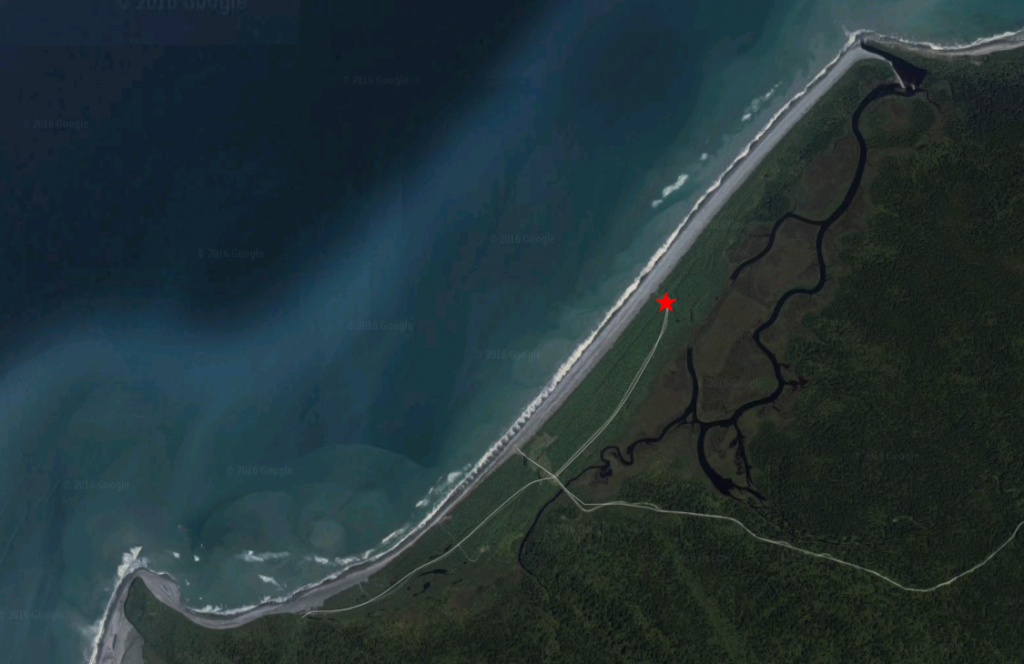 It was a marathon seven hour drive from Dunedin to the township of Fox Glacier. But rather than stick around to check out the famous river of ice, we turned down Cook Flat Rd which took us back into the countryside. We then reached the gravel Gillespies Beach road and continued down it. Just before entering the bush we encountered a frightening array of bright yellow warning signs. Narrow road! Winding road! General alarm!
It was a marathon seven hour drive from Dunedin to the township of Fox Glacier. But rather than stick around to check out the famous river of ice, we turned down Cook Flat Rd which took us back into the countryside. We then reached the gravel Gillespies Beach road and continued down it. Just before entering the bush we encountered a frightening array of bright yellow warning signs. Narrow road! Winding road! General alarm!
We bravely soldiered on, and found the road was in fact easy and well-maintained, with nary a pot hole in sight. Sure, there were some tight corners with low visibility, but overall it was much easier than anticipated.
Then it was out of the bush and a right turn to the free DOC camp site, which turned out to be a pretty nice clearing near the beach with a fireplace, picnic table and shelter as well as the usual nasty long drop toilet full of bugs.

Even though it was a long weekend we managed to stake out a decent spot to put up our tent before getting down to the business of exploring.
Tourism materials claim that the beach got its name from a miner called Gillespie who discovered gold here. However, the memoirs of Robert Logan, a prospector who claimed to have been present at the time, tell a slightly different tale. He was a member of a party of five, including Gillespie, which was heading back up the coast in 1866 after suffering disappointment at Bruce Bay. As they passed the untouched beach, they felt that it might be a good place to find gold, so loaded up on supplies in Okarito and hurried back. Logan and another man named Nelson rushed on ahead, and the pair discovered the first traces of gold before the rest of the party caught up.
According to Logan family legend, Gillespie was a popular Scottish Canadian with a fondness for boozing and billiards. He let the secret slip while on a supply trip and thus the word spread of “Gillespie’s beach” as prospectors flocked to the site to try their own luck.
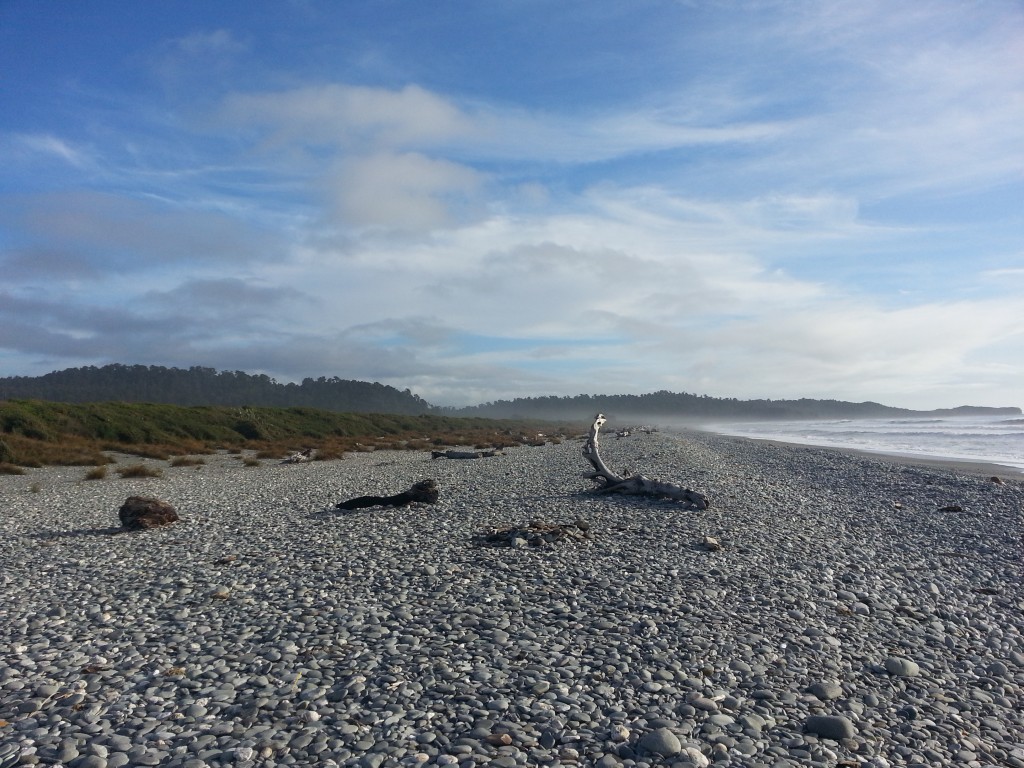
Some numbers quoted in the newspapers of the time give us an idea of the nature of the rush. In April 1866 it was reported that there were 1500 people and four stores at Gillespies Beach. By May there were 600 miners, eleven stores, two bakeries and two butcheries. By October the population had fallen to 200, there were ten stores and nine closed stores, with most remaining stores preparing to close. In 1867 the place was described as looking “very dull, only about a dozen buildings to be seen” while there were only 50 miners, three stores, one butcher and one baker. When 1868 rolled around the population was reported as being only 17.
And then in 1879 a rather curious thing had happened, with the paper reporting that the nine married couples living at the settlement had between them produced fifty children, “increasing and multiplying with a vengeance”.
Our first mission was to find the historic cemetery and pay our respects to the people for whom this beach is their final resting place. We wandered back down the road a way, past some very Shrekish sheep. Could they be…feral?
The cemetery itself is reached via a short path to a small clearing surrounded by forest.

The cemetery was officially established in 1896 but may have been unofficially used before that time. There are nine marked graves, and several more that are unmarked. One unmarked grave is surrounded by a little picket fence, small enough to suggest that the story behind it must be terribly sad. Thankfully, there is a memorial here acknowledging the pioneers, so it isn’t quite so tragic to know that some people lie here unremembered.
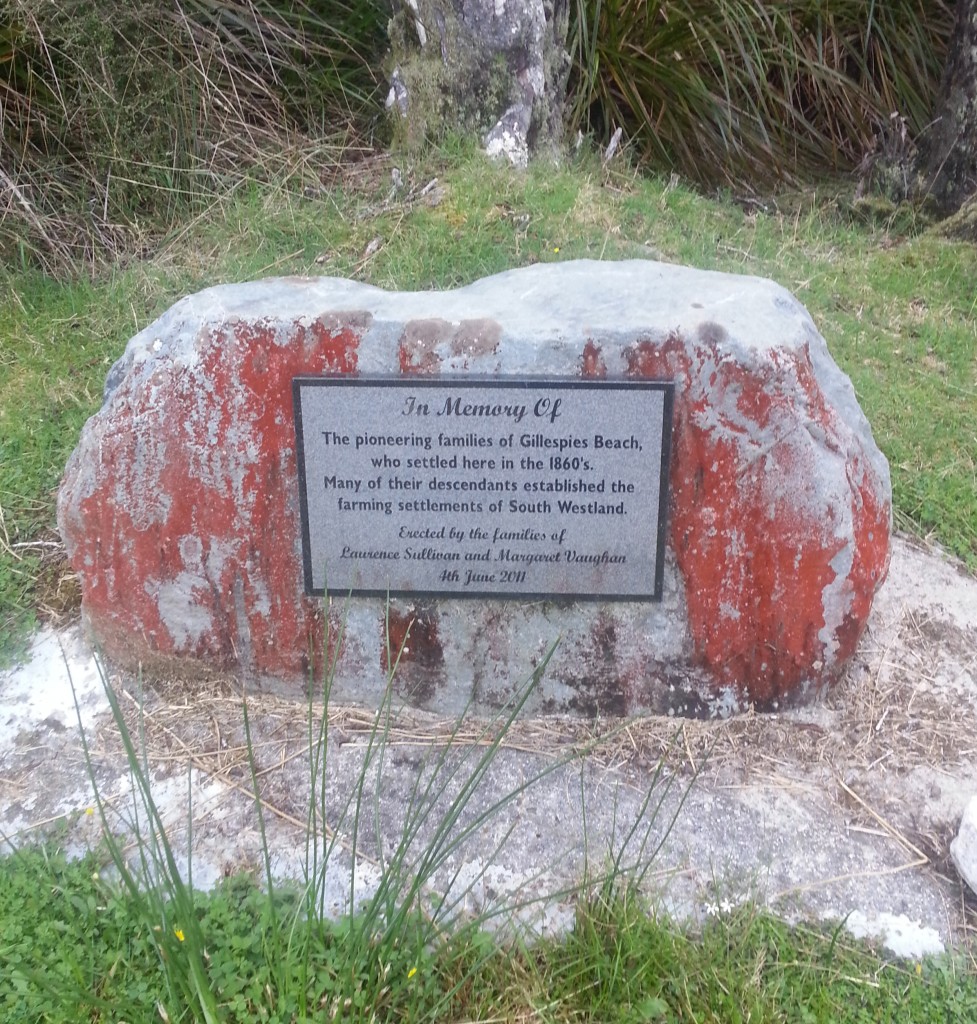
One of the first headstones you will encounter is that of Edward Ryan, better known as Ned or Neddy. He was the keeper of a hotel and store, one of the few residents of Gillespies Beach who intended to settle permanently. At the Gillespies Beach Hotel guests could enjoy succulent goose cooked by his wife Catherine as well as participate in card games. But in 1899 this pillar of the community suffered an ignominious end when he fell from his horse aged 57 years. He was followed by his son Thomas, who died of tuberculosis in 1900. Another of his sons, John Edward Ryan, intended to sell the hotel and the family’s run of 1800 acres with 400 head of cattle, 800 sheep and 35 horses along with a 14 room house. Unfortunately, he too passed away from the disease in 1902 at only 31 years of age and was interred with his father.
By 1903 Catherine Ryan, the bereaved wife and mother, was offering it all for sale with the intention of leaving for the North Island, and who can blame her? Her husband may have loved the West Coast, but what comfort would that be after such losses?
The next grave is unusual. It commemorates James O’Leary, but was erected by our friend Ned Ryan. James was cared for in his last hours at Ned’s Hotel, and while it’s said that he was an old and respected member of the community, it was Ned who nursed him in his final three weeks of illness, and Ned who paid for his headstone. Perhaps poor James had no family of his own.
The next two graves belong to John and Annie Quinlan. All I could discover of these two was that John was a trustee of the cemetery and that the nearby creek is marked as Quinlan Creek on some maps.

Nearby is the headstone of Patrick Carroll who in 1890 “was drowned in Cook’s River” aged 17 years. The inscription seems innocuous (though sad), but takes on a shade of blame once you learn the full story. The young man drowned attempting to cross the Cook River in the absence of Robert McIntosh, the appointed ferryman. Apparently there had been many complaints about the conduct of McIntosh, and the bereaved father, Michael Carroll, felt the the ferryman was at fault for the accident, saying “I blame him for it the longest day I live”. The issue divided the small community, with the Ryan family taking the Carroll’s side, and friends of McIntosh collecting a petition of 45 names attesting to his “courtesy and efficiency”. Ned Ryan blasted the petition, suggesting that some of the names were forged and others belonged to people who hadn’t used the ferry in years.

Robert McIntosh’s headstone is not far from Patrick Carroll’s. Only two years later he too was drowned while attempting to cross the Saltwater Creek, for which he also manned a ferry. He was mourned by his wife and seven children.
As for Michael Carroll, he mined Gillespies Beach for 36 years before retiring to Wellington, where he passed away at the age of 73. He was survived by four daughters and two sons.
Henry Morrison was a respected miner of English descent who, with a partner, constructed a water race to address the water issues which caused problems for the local miners. I could find very little about James Walsh, except that he left behind a large family.
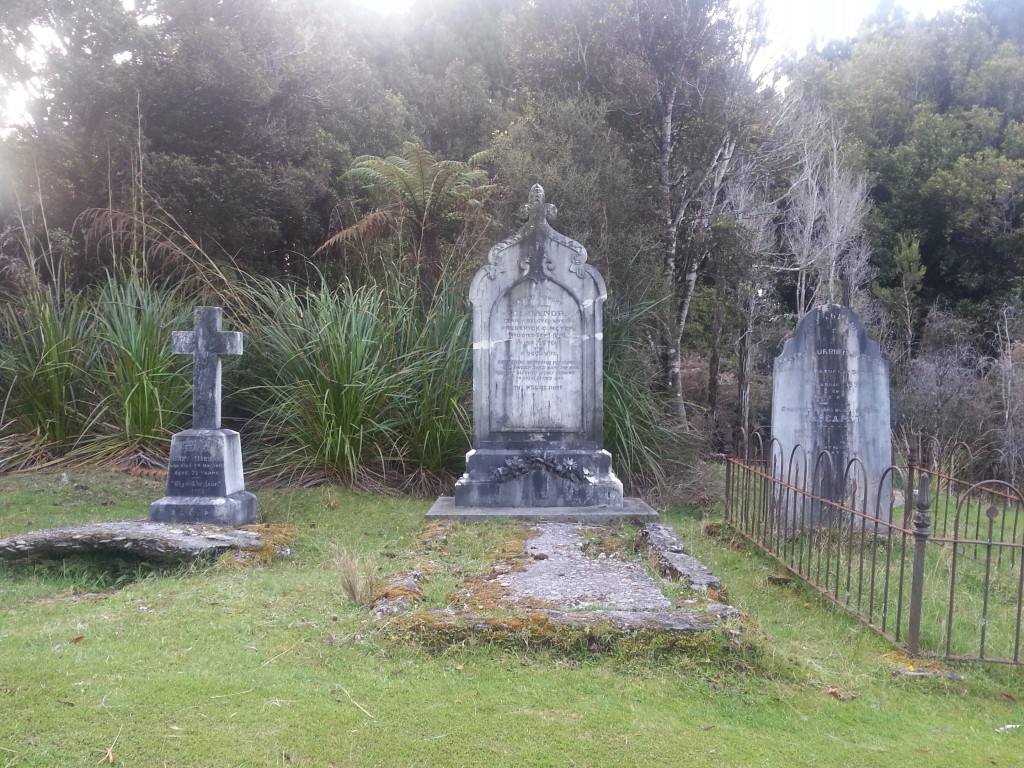
The most elaborate headstone in this small cemetery belongs to Eleanor Meyer and was erected by her husband Frederick. The elderly woman was feeding her chickens one afternoon in 1898 when she experienced a pain in her chest. Her husband tried to help, but was unable to save her. Eleanor was praised for the dedications she showed to her housework until her very last day.
This story has a tragic addendum. Eight years later Frederick’s body was found near Five Mile Beach. The 67-year-old had been embroiled in a court case and had ended his life by taking arsenic. And one of the unmarked graves here may belong to Edward Mortley, who also took his own life. It seems that suicide was a common cause of death for West Coast miners, suggesting that life in these rugged outposts was not only physically trying, but psychologically difficult as well.
It was with sober hearts that we returned to the camp ground. Nearby is another relic that is worth investigating – the scattered remains of the suction dredge that operated briefly here beginning in 1891. The dredge, designed by Edward von Schmidt, had impressed a scout with its ability to clear out channels in the San Francisco Bay, and so one was ordered by the company of J & A Anderson to be built on Gillespies Beach. The “cutter”, or vertical element that would loosen the sand, is mounted near the car park.
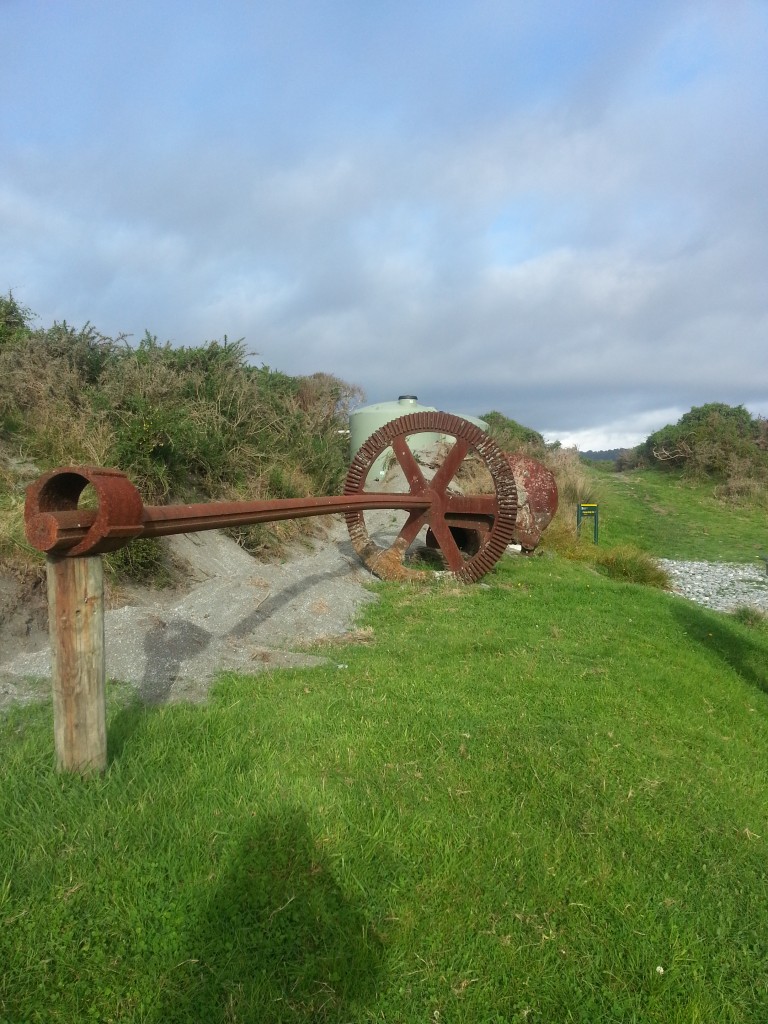
We proceeded on to the short loop walk beyond which would lead us to more dredge parts.
When established, this was said to be “the most powerful dredger ever placed on South Westland beaches” and the little community had high hopes that the business would provide a revitalising economic boost to the area.

However it soon became apparent that the design was not suitable for the environment. The suction mechanism was constantly being clogged by branches and stones.
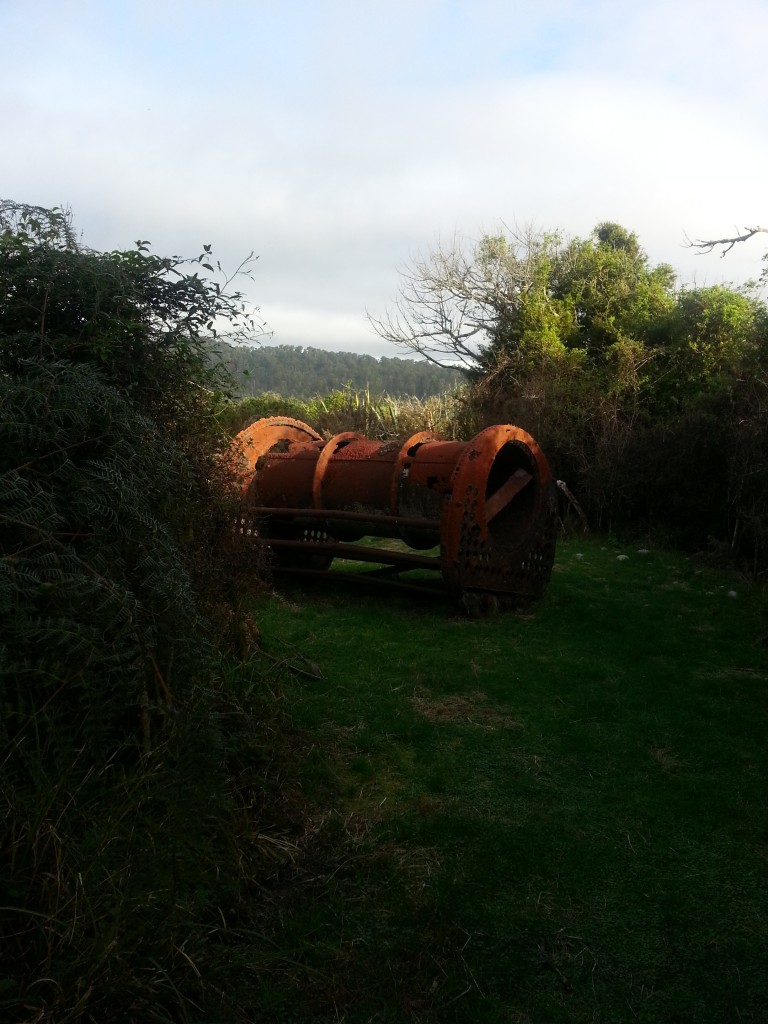
The company collapsed after only one year. They had spent £5000 and not passed a single ton of sand for gold collection. Worse, it claimed the life of engineer in charge Job Hartwell who was pulled into the machinery while his son who was acting as assistant could only look on in horror.
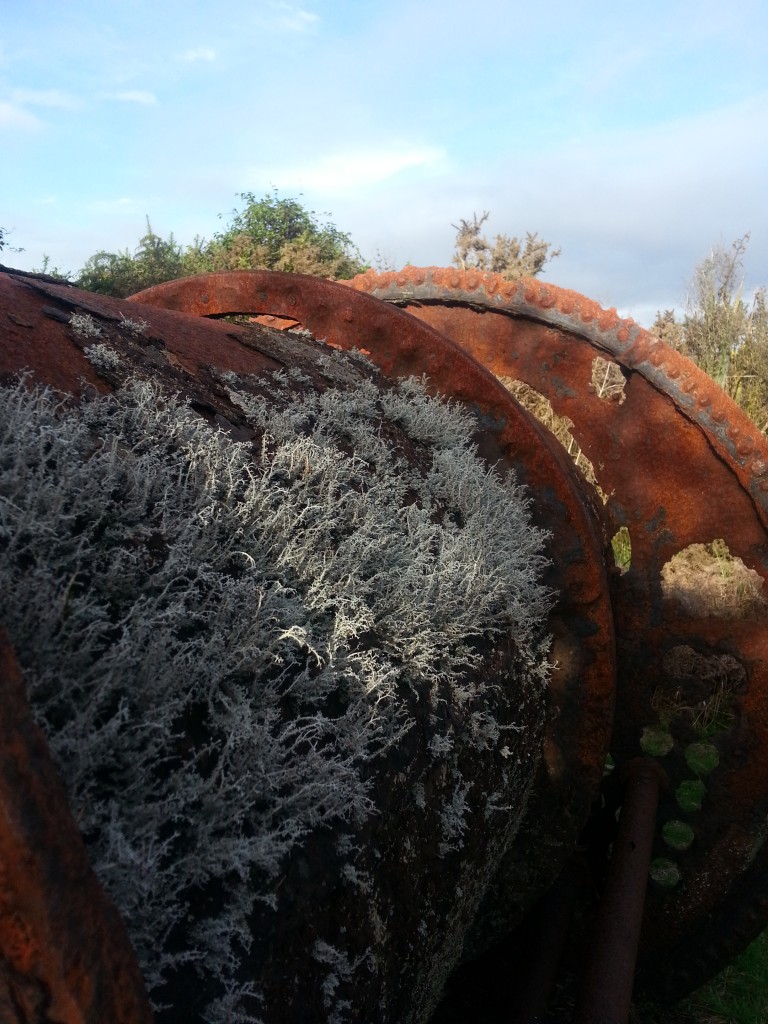
As the sun began to set, we left the rusted machine that had disappointed a community, ruined investors, and left a family without a father, all in only a year. We returned to the beach, where our spirits were lifted by the sight of a cheerful little friend.

The evening concluded with what was surely the most beautiful sunset I have ever witnessed. I joined my fellow campers on the beach to watch the show.
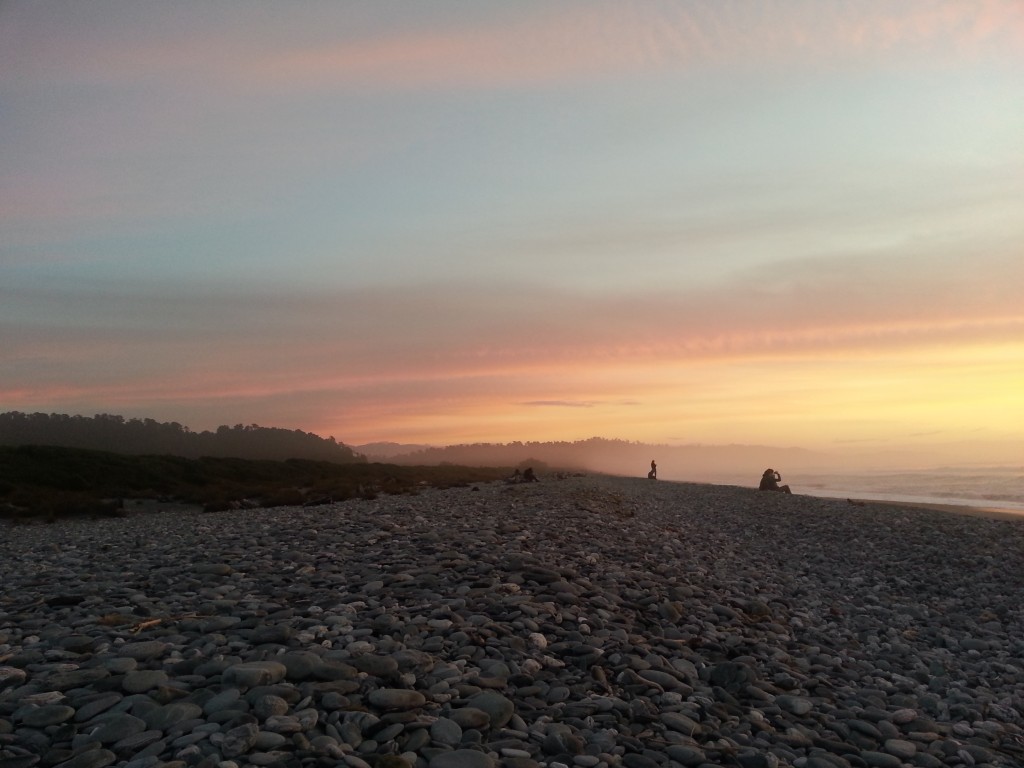
Clearly this place is not all misery! The pioneers may have had hard lives, but perhaps they sat on this very beach and marvelled at the beauty before them, just as I do now, a hundred years later.

With that, we retired to bed, ready to continue our adventure in the morning. But I’ve already gone on too long, so that is a story for another post.
References:
Logan, R. 1992: How Gillespie’s Beach got its name. The Press (6 May): 17
THE WEST CANTERBURY GOLDFIELDS. Lyttelton Times, Volume XXV, Issue 1675, 30 April 1866, Page 2
WEST CANTERBURY GOLDFIELDS. Press, Volume IX, Issue 1103, 22 May 1866, Page 3
WESTLAND. Press, Volume X, Issue 1217, 1 October 1866, Page 2
WESTLAND Press, Volume XI, Issue 1307, 15 January 1867, Page 3
WARDEN’S REPORT. West Coast Times , Issue 859, 24 June 1868, Page 3
GOVERNMENT BILLS. Evening Post, Volume XVIII, Issue 91, 14 October 1879, Page 2
A TRIP TO THE HAAST RIVER. Grey River Argus, Volume III, Issue 166, 5 February 1867, Page 3
GOVERNMENT BILLS. Evening Post, Volume XVIII, Issue 91, 14 October 1879, Page 2
West Coast Times. SATURDAY, AUGUST 1, 1896. West Coast Times , Issue 10340, 1 August 1896, Page 2
Page 3 Advertisements Column 2 Grey River Argus , 13 November 1903, Page 3
West Coast Times. TUESDAY, MARCH 1. 1892. West Coast Times , Issue 9263, 1 March 1892, Page 2
WESTLAND COUNTY COUNCIL. West Coast Times , Issue 8073, 12 February 1891, Page 2
Untitled West Coast Times , 11 January 1910, Page 2
DEATH. West Coast Times , Issue 11288, 10 May 1899, Page 2
NEWS AND NOTES. Grey River Argus , 18 May 1911, Page 1
West Coast Times. WEDNESDAY, MAY 2, 1888. West Coast Times , Issue 7077, 2 May 1888, Page 2
THE INQUEST West Coast Times , Issue 13610, 20 October 1905, Page 4
West Coast Times. TUESDAY, NQVEMBER 6, 1894. West Coast Times , Issue 9956, 6 November 1894, Page 2
Wast Coast Times. TUESDAY, JUNE 9, 1891. West Coast Times , Issue 9045, 9 June 1891, Page 2
NEW COUNTRY FOR TOURISTS. Press, Volume XLVIII, Issue 7954, 31 August 1891, Page 3
IN MEMORIAM. Star , Issue 5327, 3 August 1895, Page 4
THE GILLESPIES ACCIDENT. West Coast Times , Issue 9334, 2 August 1892, Page 4
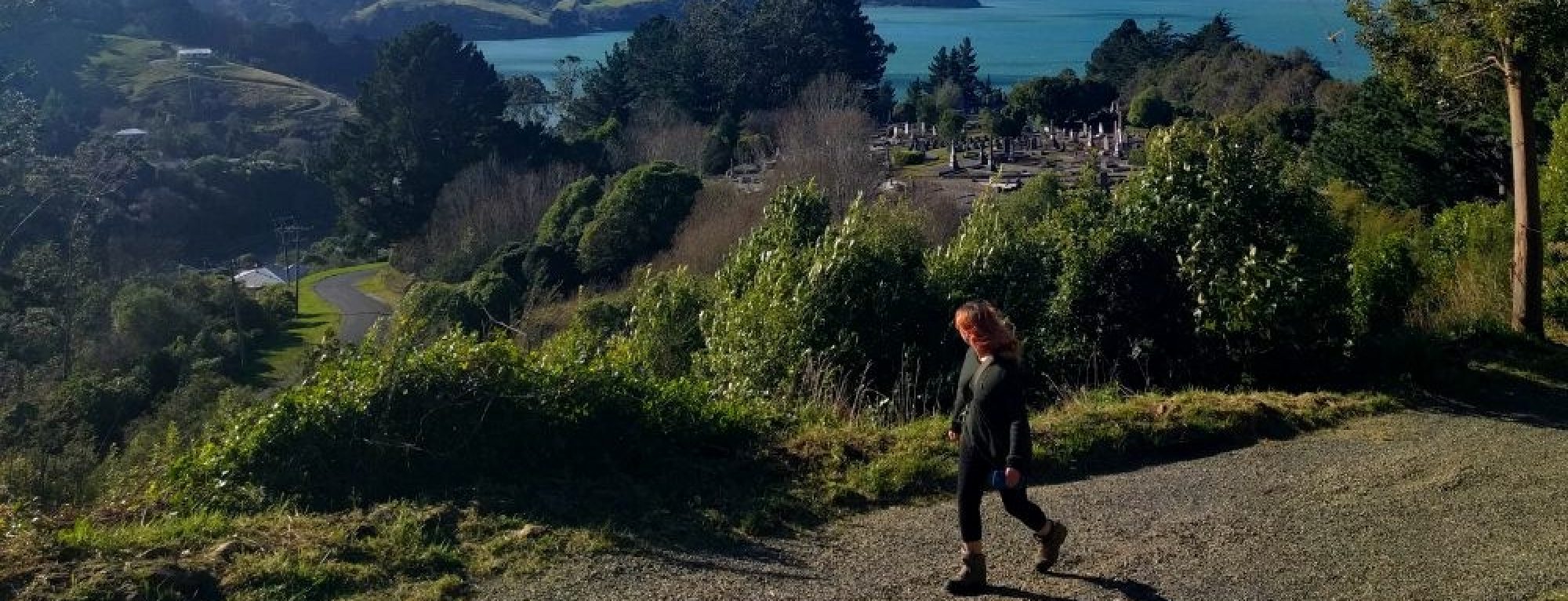

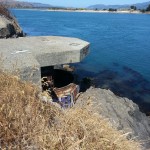
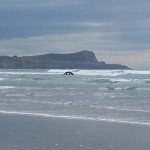
Visited many years ago – to find two old brothers who lived in a converted railway carriage
who fed us possum soup for lunch ! although didn’t tell us till afterwards…they took us to the cemetery and the seal colony.
A hauntingly beautiful place…..and treasured memory.
What a great memory! Thanks for sharing!
I guess that was John and Mark Shaw, a great couple of old timers who treated visitors exceptionally well and their visitors book showed their popularity. The pussy cat inn was one of the buildings. John said he hada electric start fitted to the generator because Mark was too old to crank it but Mark tlod us that it was John that was too old to crank it
Yep,Mark and John were great west coast characters.Both had lived there for many many years and were retired gold diggers.There were good friends with my family and we would often stay their back in the 70’s and 80’s in the huts one called by memory the “Hot Box” lol in our hoildays.They both had a great sense of humor with many a good tale to tell,My father even had his second marriage their beside their home in the early 80’s with Mark & John helping to set it all up…Great memories…R.I.P to the both of them.
A few typos in the above… darn predictive text thingy lol
Thanks for sharing. Hope to visit this Xmas
You won’t be disappointed. It’s a wonderful place!
We also visited mark and John over 40 years ago with the mother of a friend who was
a true West Coaster instead of going to the Kumara races as it was raining. A long drive from Hokitika return and with a 16 month old. A truly wonderful experience and we have never forgotten their hospitality. Plus we still have not been to the Kumara Races
My grandfather was Michael W Carroll deceased approx 1978. His father was Michael Carroll… road man for this area. Great grandmother was Mary. Her short life is commerated by a stained glass window in the Franz Catholic church. These Carrolls lived in the house at the end of the Franz bridge. Most of the children were born either at the Franz or at Gillespies Beach. I have a stunning gold watch chain that my great grandfather had made from gold from the black sands of the beach. I am somewhat confused as to the identity of the Michael Carroll in the article. His widow leaving for Wellington and the 6 children
I think the author may have incorrect information. Great granddad Michael ended up in Hokitika and is buried in our family plot in Hokitika. His children… James, Patrick, Eily, Michael, Rita, Molly, and one whose name escapes me (mechanic.. never married.. lived at Sunnyside for many many years) Pat and Molly eventually lived in Wellington but the rest stayed close to the Coast.
Adding to the above post.. the missing name is Jack Carroll
Hi Martin, lovely story of Gillespies Beach and the people who lived there during those times. I am presently writing our family history and as my Grandmother Julia Carroll was the daughter of the pioneer, Michael Carroll, and a sister to Patrick Carroll who drowned in the Cook River, I may be able to answer your question in regard to your Great Great Grandfather, Michael Carroll from Ireland.
This was a place often visited by my father in the early years of the Shaw brothers who originated from Reefton they were most hospitable gentalmen and had a beautiful garden as I recall this was1950 s and the stories of ghosts were abundant
Hello!
Interesting stories. My Great great grandfather was the first School teacher at Gillespies. He arrived there from the goldmines of Victoria (Aus). Later became very prominent in the development of coal mining further up the coast around Westport. Cheers, Greg.